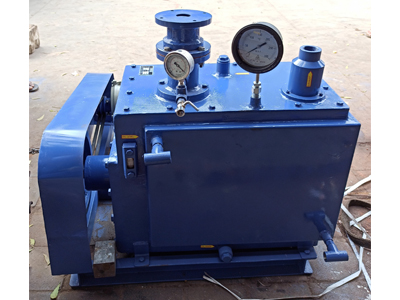Oil Lubricated Vacuum Pump
 Make Enquiry
Make Enquiry
An oil-lubricated vacuum pump is a type of mechanical pump that uses oil to lubricate and seal the internal components while creating a vacuum. This type of pump is often used in industries that require efficient, reliable vacuum creation. Here’s a more detailed look into its operation, advantages, and typical applications:
How it works:
- Lubrication: The oil within the pump lubricates moving parts like rotors, vanes, or pistons, reducing friction and wear. This ensures smooth operation and minimizes heat buildup.
- Sealing: The oil helps to create an airtight seal between moving components, which is critical for maintaining the vacuum and preventing air from leaking into the system.
- Cooling: The oil also absorbs and dissipates heat produced by the pump during operation, keeping the pump cooler and improving its efficiency.
Rotary Vane Vacuum Pump:
- This is the most common type of oil-lubricated vacuum pump. It uses a set of rotating vanes that slide in and out of a rotor, compressing the air inside the pump chamber and creating the vacuum.
- The oil seals the gap between the vanes and the pump casing, which is crucial for maintaining high efficiency and achieving deep vacuum levels.
Advantages
- High Efficiency: Oil-lubricated pumps are more efficient at creating deep vacuums compared to oil-free models .
- Durability: The oil helps reduce wear on internal components, extending the pump's lifespan.
- Reliable Performance: These pumps are less prone to overheating and can operate under higher workloads.
- Quiet Operation: Oil can dampen sound, making oil-lubricated pumps quieter than their oil-free counterparts.
Applications
- Industrial and Manufacturing: Used in processes such as vacuum packaging, degassing, and in systems requiring vacuum for materials handling or molding.
- Automotive: Often used in air conditioning systems for evacuating refrigerants and other tasks.
- Laboratories: Employed in scientific applications that require a deep, stable vacuum for processes such as distillation, freeze-drying, or scientific research.
- HVAC Systems: Used for evacuation of refrigerant lines during system installation or maintenance.
Maintenance Tips:
- Check Oil Regularly: Ensure that the oil level remains adequate and that it hasn’t become contaminated. Replace the oil periodically according to the manufacturer's recommendations.
- Change Oil Filters: Some pumps have oil filters that need to be replaced to ensure optimal performance and to prevent contamination.
- Monitor for Leaks: Regularly inspect the pump for oil leaks or damage to seals that could affect performance.
- Keep the Pump Clean: Dust and dirt can contaminate the oil and the pump's internal components. Clean the exterior of the pump regularly and ensure that the ventilation is unobstructed.
In summary, oil-lubricated vacuum pumps are known for their reliability and efficiency in creating deep vacuums, but they require careful maintenance, especially with respect to oil levels and cleanliness, to ensure optimal performance.
